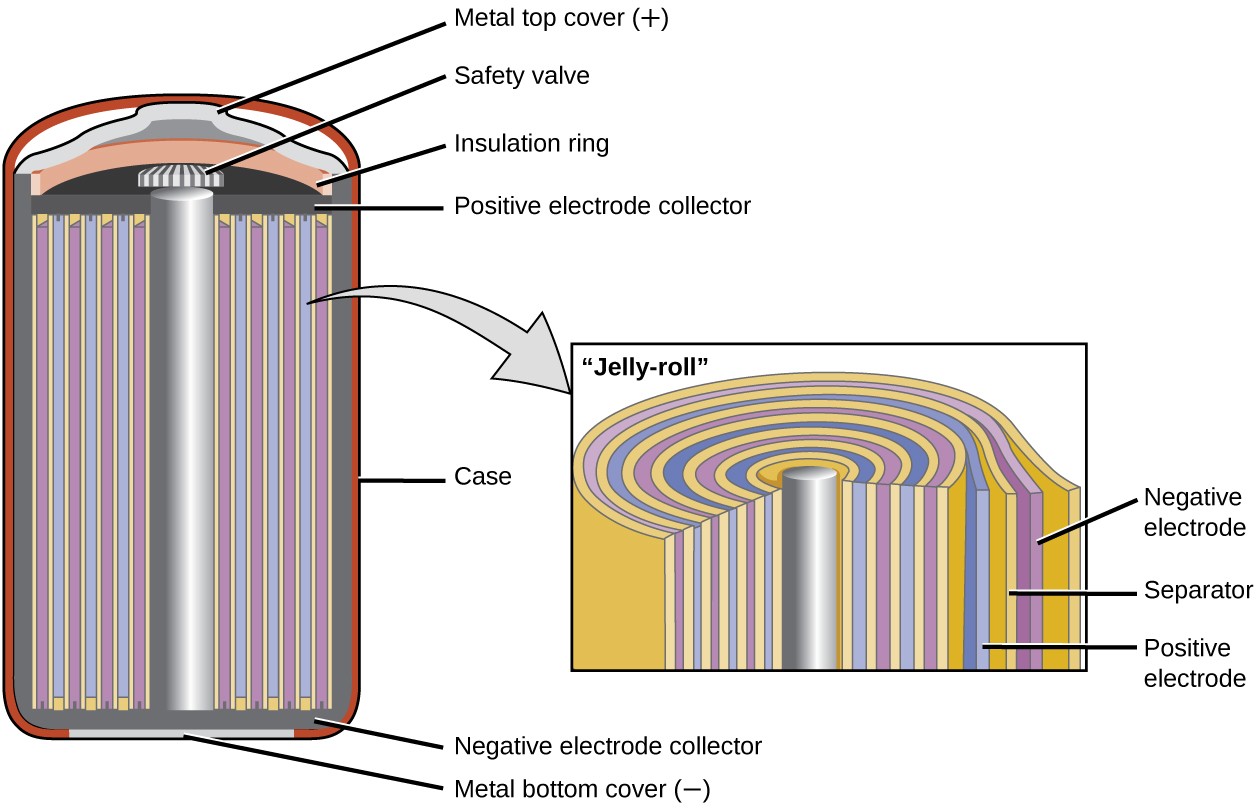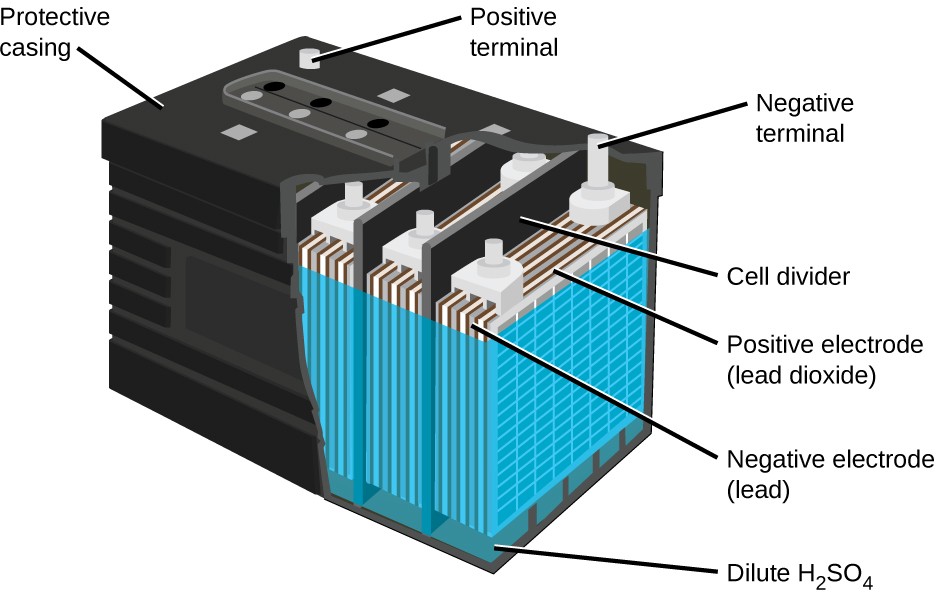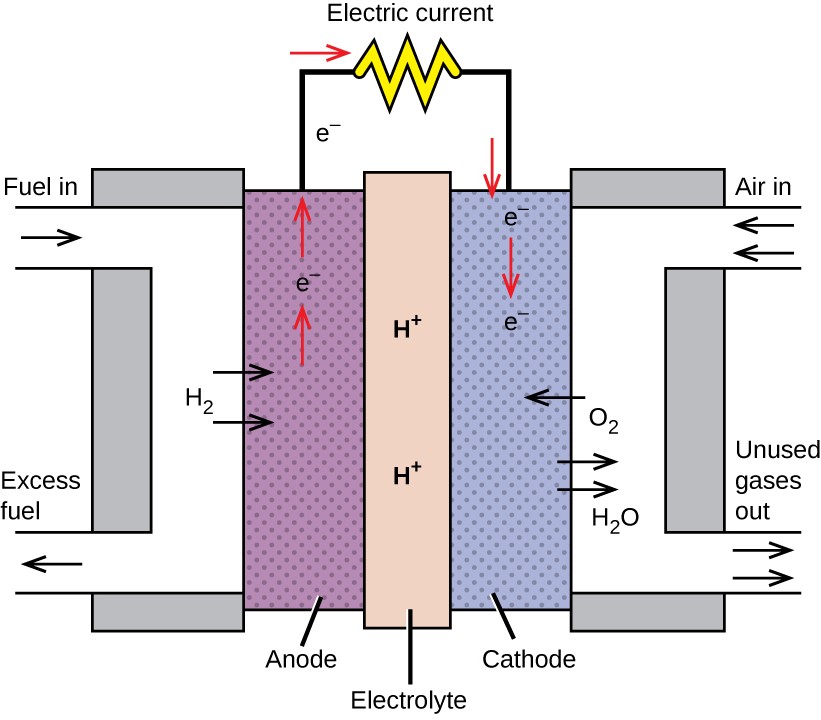Private: Chapter Seventeen
Batteries and Fuel Cells (17.5)
OpenStax
Learning Objectives
By the end of this section, you will be able to:
- Describe the electrochemistry associated with several common batteries
- Distinguish the operation of a fuel cell from that of a battery
TED show – “How Batteries Work”
The Truth about Tesla Model 3 Batteries
There are many technological products associated with the past two centuries of electrochemistry research, none more immediately obvious than the battery. A battery is a galvanic cell that has been specially designed and constructed in a way that best suits its intended use a source of electrical power for specific applications. Among the first successful batteries was the Daniell cell, which relied on the spontaneous oxidation of zinc by copper(II) ions (Figure 17.8):
Zn(s) + Cu2 + (aq) ⟶Zn2 + (aq) + Cu(s)

Figure 17.8 Illustration of a Daniell cell taken from a 1904 journal publication (left) along with a simplified illustration depicting the electrochemistry of the cell (right). The 1904 design used a porous clay pot to both contain one of the half-cell’s content and to serve as a salt bridge to the other half-cell.
Modern batteries exist in a multitude of forms to accommodate various applications, from tiny button batteries that provide the modest power needs of a wristwatch to the very large batteries used to supply backup energy to municipal power grids. Some batteries are designed for single-use applications and cannot be recharged (primary cells), while others are based on conveniently reversible cell reactions that allow recharging by an external power
source (secondary cells). This section will provide a summary of the basic electrochemical aspects of several batteries familiar to most consumers, and will introduce a related electrochemical device called a fuel cell that can offer improved performance in certain applications.
Link to Learning
Watch this video to learn more about batteries.
Single-Use Batteries
A common primary battery is the dry cell, which uses a zinc can as both container and anode (“–” terminal) and a graphite rod as the cathode (“+” terminal). The Zn can is filled with an electrolyte paste containing manganese(IV) oxide, zinc(II) chloride, ammonium chloride, and water. A graphite rod is immersed in the electrolyte paste to complete the cell. The spontaneous cell reaction involves the oxidation of zinc:
anode reaction: Zn(s) ⟶ Zn2+(aq) + 2e−
and the reduction of manganese(IV)
reduction reaction: 2MnO2(s) + 2NH4 Cl(aq) + 2 e− ⟶ Mn2 O3(s) + 2NH3(aq) + H2 O(l) + 2Cl−
which together yield the cell reaction:
cell reaction: 2MnO2(s) + 2NH4 Cl(aq) + Zn(s) ⟶ Zn2+(aq) + Mn2 O3(s) + 2NH3(aq) + H2 O(l) + 2Cl− Ecell ~ 1.5 V
The voltage (cell potential) of a dry cell is approximately 1.5 V. Dry cells are available in various sizes (e.g., D, C, AA, AAA). All sizes of dry cells comprise the same components, and so they exhibit the same voltage, but larger
cells contain greater amounts of the redox reactants and therefore are capable of transferring correspondingly greater amounts of charge. Like other galvanic cells, dry cells may be connected in series to yield batteries with greater voltage outputs, if needed.

Figure 17.9 A schematic diagram shows a typical dry cell.
Link to Learning
Alkaline batteries (Figure 17.10) were developed in the 1950s to improve on the performance of the dry cell, and they were designed around the same redox couples. As their name suggests, these types of batteries use alkaline electrolytes, often potassium hydroxide. The reactions are
anode:Zn(s) + 2OH−(aq) ⟶ ZnO(s) + H2 O(l) + 2e−
cathode: 2MnO2(s) + H2 O(l) + 2e− ⟶ Mn2 O3(s) + 2OH−(aq)
cell: Zn(s) + 2MnO2(s) ⟶ ZnO(s) + Mn2 O3(s) Ecell = +1.43 V
An alkaline battery can deliver about three to five times the energy of a zinc-carbon dry cell of similar size. Alkaline batteries are prone to leaking potassium hydroxide, so they should be removed from devices for long-term storage. While some alkaline batteries are rechargeable, most are not. Attempts to recharge an alkaline battery that is not rechargeable often leads to rupture of the battery and leakage of the potassium hydroxide electrolyte.

Figure 17.10 Alkaline batteries were designed as improved replacements for zinc-carbon (dry cell) batteries.
Link to Learning
Rechargeable (Secondary) Batteries
Nickel-cadmium, or NiCd, batteries (Figure 17.11) consist of a nickel-plated cathode, cadmium-plated anode, and a potassium hydroxide electrode. The positive and negative plates, which are prevented from shorting by the separator, are rolled together and put into the case. This is a “jelly-roll” design and allows the NiCd cell to deliver much more current than a similar-sized alkaline battery. The reactions are
anode:Cd(s) + 2OH−(aq) ⟶ Cd(OH)2(s) + 2e−
cathode: NiO2(s) + 2H2 O(l) + 2e− ⟶ Ni(OH)2(s) + 2OH−(aq)
cell: Cd(s) + NiO2(s) + 2H2 O(l) ⟶ Cd(OH)2(s) + Ni(OH)2(s) Ecell ~ 1.2 V
When properly treated, a NiCd battery can be recharged about 1000 times. Cadmium is a toxic heavy metal so NiCd batteries should never be ruptured or incinerated, and they should be disposed of in accordance with relevant toxic waste guidelines.

Figure 17.11 NiCd batteries use a “jelly-roll” design that significantly increases the amount of current the battery can deliver as compared to a similar-sized alkaline battery.
Link to Learning
Lithium ion batteries (Figure 17.12) are among the most popular rechargeable batteries and are used in many portable electronic devices. The reactions are
anode:LiCoO2 ⇌ Li1−x CoO2 + x Li+ + x e−
cathode: x Li+ + x e− + x C6 ⇌ x LiC6
cell:LiCoO2 + x C6 ⇌ Li1−x CoO2 + x LiC6 Ecell ~ 3.7 V
The variable stoichiometry of the cell reaction leads to variation in cell voltages, but for typical conditions, x is usually no more than 0.5 and the cell voltage is approximately 3.7 V. Lithium batteries are popular because they can provide a large amount current, are lighter than comparable batteries of other types, produce a nearly constant voltage as they discharge, and only slowly lose their charge when stored.

Figure 17.12 In a lithium ion battery, charge flows as the lithium ions are transferred between the anode and cathode.
Link to Learning
The lead acid battery (Figure 17.13) is the type of secondary battery commonly used in automobiles. It is inexpensive and capable of producing the high current required by automobile starter motors. The reactions for a lead acid battery are
anode:Pb(s) + HSO4 −(aq) ⟶ PbSO4(s) + H+(aq) + 2e−
cathode: PbO2(s) + HSO4 −(aq) + 3H+(aq) + 2e− ⟶ PbSO4(s) + 2H2 O(l)
cell:Pb(s) + PbO2(s) + 2H2 SO4(aq) ⟶ 2PbSO4(s) + 2H2 O(l) Ecell ~ 2 V
Each cell produces 2 V, so six cells are connected in series to produce a 12-V car battery. Lead acid batteries are heavy and contain a caustic liquid electrolyte, H2SO4(aq), but are often still the battery of choice because of their high current density. Since these batteries contain a significant amount of lead, they must always be disposed of properly.

Figure 17.13 The lead acid battery in your automobile consists of six cells connected in series to give 12 V.
Link to Learning
Fuel Cells
A fuel cell is a galvanic cell that uses traditional combustive fuels, most often hydrogen or methane, that are continuously fed into the cell along with an oxidant. (An alternative, but not very popular, name for a fuel cell is a flow battery.) Within the cell, fuel and oxidant undergo the same redox chemistry as when they are combusted, but via a catalyzed electrochemical that is significantly more efficient. For example, a typical hydrogen fuel cell uses graphite electrodes embedded with platinum-based catalysts to accelerate the two half-cell reactions:

Figure 17.14 In this hydrogen fuel cell, oxygen from the air reacts with hydrogen, producing water and electricity.
Anode:2H2(g) ⟶ 4H+(aq) + 4e−
Cathode: O2(g) + 4H+(aq) + 4e− ⟶ 2H2O(g)
Cell:2H2(g) + O2(g) ⟶ 2H2O(g) Ecell ~ 1.2 V
These types of fuel cells generally produce voltages of approximately 1.2 V. Compared to an internal combustion engine, the energy efficiency of a fuel cell using the same redox reaction is typically more than double (~20%–25% for an engine versus ~50%–75% for a fuel cell). Hydrogen fuel cells are commonly used on extended space missions, and prototypes for personal vehicles have been developed, though the technology remains relatively immature.
Link to Learning
Check out this link to learn more about fuel cells.

